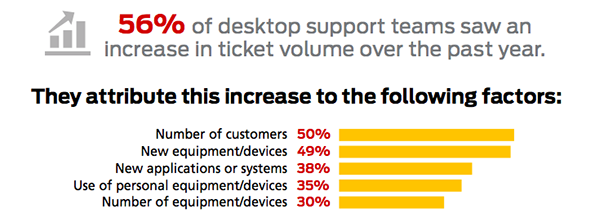Date Published January 25, 2017 - Last Updated December 6, 2017
One of the indicators of how things are going in the support center and/or desktop support is whether the number of tickets they handle is going up or down. Since we started conducting research specific to desktop support in 2011, more than half the organizations responding have indicated an increase in tickets year over year. Last year was no exception. In the HDI 2016 Technical Support Practices & Salary Report, 56 percent of the 618 respondent organizations indicated that the number of tickets had risen.
More than half the organizations responding have indicated an increase in tickets.

When we look into why the number of tickets has increased, we can see indications of business improvement. The top five reasons for the ticket increase are shown in the graphic below.

For half the organizations represented in the report, the reason for the ticket increase was simple: more customers. In general, that means the number of employees being supported has gone up. Businesses have been hiring, and that’s good. For just under half the organizations, desktop support has been busy with new equipment or devices (compared with 19 percent of organizations citing older equipment as a reason for the increase). Many of the tickets are, no doubt, service requests connected with the new equipment or devices. We cannot be more specific than that, because only 52 percent of desktop support organizations measure incidents and requests separately. Our report does show elsewhere, however, that 83 percent of desktop support organizations oversee the provisioning of new hires, with the same percentage being responsible for overseeing hardware and software procurement.
Another positive business indicator is the third most common reason cited for ticket increase: new applications or systems. Software is being updated and/or replaced, along with the systems that support the applications. Whenever new systems and applications are made available, the number of tickets (both requests and incidents) tends to rise, as we know, at least temporarily.
As we would expect, the number of devices being used by desktop support’s customers has gone up, and in 35 percent of organizations, the use of personal devices is one of the top reasons desktop support has more work this year. Consider that an initiative intended to decrease the amount of work IT staff would be doing (BYOD), has in fact contributed to the increase of support work in a substantial number of organizations year after year. Personal devices must be connected to the corporate network, often requiring the installation of required software, and this work falls to desktop support.
In Remote Control and the Changing Role of Desktop Support, I delve into what makes up a modern desktop support organization, and it isn’t swapping motherboards and hard drives anymore.
 Roy Atkinson is HDI's senior writer/analyst, acting as in-house subject matter expert and chief writer for SupportWorld articles and white papers. In addition to being a member of the HDI International Certification Standards Committee and the HDI Desktop Support Advisory Board, Roy is a popular speaker at HDI conferences and is well known to HDI local chapter audiences. His background is in both service desk and desktop support as well as small-business consulting. Roy is highly rated on social media, especially on the topics of IT service management and customer service. He is a cohost of the very popular #custserv (customer service) chat on Twitter, which celebrated its fifth anniversary on December 9, 2014. He holds a master’s certificate in advanced management strategy from Tulane University’s Freeman School of Business, and he is a certified HDI Support Center Manager. Follow him on Twitter @HDI_Analyst and @RoyAtkinson.
Roy Atkinson is HDI's senior writer/analyst, acting as in-house subject matter expert and chief writer for SupportWorld articles and white papers. In addition to being a member of the HDI International Certification Standards Committee and the HDI Desktop Support Advisory Board, Roy is a popular speaker at HDI conferences and is well known to HDI local chapter audiences. His background is in both service desk and desktop support as well as small-business consulting. Roy is highly rated on social media, especially on the topics of IT service management and customer service. He is a cohost of the very popular #custserv (customer service) chat on Twitter, which celebrated its fifth anniversary on December 9, 2014. He holds a master’s certificate in advanced management strategy from Tulane University’s Freeman School of Business, and he is a certified HDI Support Center Manager. Follow him on Twitter @HDI_Analyst and @RoyAtkinson.